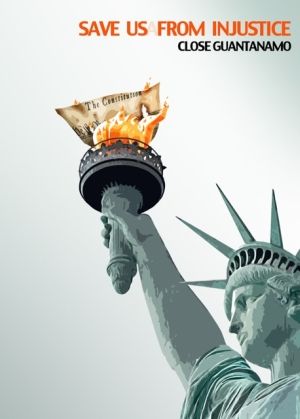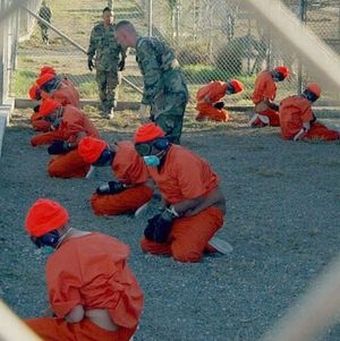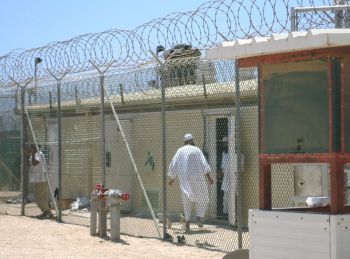
Publisher:
Bonnie King
CONTACT:
Newsroom@Salem-news.com
Advertising:
Adsales@Salem-news.com

~Truth~
~Justice~
~Peace~
TJP
Jan-09-2012 11:49

 TweetFollow @OregonNews
TweetFollow @OregonNews
Obama's Broken Promise on Gitmo's Tenth Anniversary
Ralph E. Stone Salem-News.comIn addition to the military prison at Guantanamo, the base also included CIA “black sites” where renditions or extrajudicial, secret abductions and transfers of prisoners to overseas locations where torture was used.
 Poster by Maria Shirshova |
(SAN FRANCISCO) - January 11, 2012 marks the tenth anniversary of the Guantanamo Bay prison, an extrajudicial
Actually, Guantanamo is just one of many prisons holding terrorists. Other prisons across the U.S. hold convicted terrorists. According to the New York Times, as of October 1, 2011, the Bureau of Prisons was holding 362 prisoners convicted of terrorism-related crimes, 269 with a connection to international terrorism, and an additional 93 inmates with a connection to domestic terrorism. www.nytimes.com/2011/12/11/
At one time, the U.S. paid a bounty for the capture of supposed terrorists. Consider the case of Mohammed el Gorani, a teenager from Chad, who was in Pakistan looking for work. One day he was praying at a mosque. All of sudden soldiers surrounded the mosque. Because he was a foreigner, he was taken to prison where he interrogated about his relationship with al-Qaida and the Taliban, names he had never heard of. He was beaten and tortured. The Pakistani guards told him to say he was al-Qaida and if he did so, he would be released. He obliged.
All of a sudden he was in U.S. custody and ended up at Guantanamo’s Camp X-ray, which was nothing more than fenses with no walls or roof, nothing to protect prisoners from the sun or rain. He was interrogated every night and endured torture. Finally in 2004, civilian lawyers were allowed to visit prisoners. Because el Gorani was a minor, he was chosen as a client.
At a trial four years later, the judge ordered his release. In June 2009, a military plane dropped him at N’Djamena airport in Chad. He needed medical treatment as a result of his mistreatment at Guantanamo. A full account of Mohammed el Gorani’s ordeal can be found at Diary by Mohammed el Gorani and Jérôme Tubiana <www.lrb.co.uk/v33/n24/

According to the Center for the Study of Human Rights in the Americas as many as 46 children have entered Guantanamo as children. <http://humanrights.ucdavis.
According to The Justice Campaign, the following torture techniques were used at Guantanamo: sexual assault/humiliation; sleep deprivation; sensory deprivation; solitary confinement/isolation; mock executions; forced medications; use of dogs to scare detainees; temperature extremes; sensory bombardment (noise); watching others being tortured; and various psychological techniques to induce regression, psychic disintegration, and feelings of helplessness that lower detainees’ defenses. http://thejusticecampaign.
In addition to the military prison at Guantanamo, the base also included CIA “black sites” where renditions or extrajudicial, secret abductions and transfers of prisoners to overseas locations where torture was used. These abductees often ended up at Guantanamo’s Camp Seven, a special prison used to hold these “high value” detainees previously held in these black sites around the world.
On June 29, 2006, the U.S. Supreme Court ruled in Hamdan v. Rumsfeld, 548 U.S. 557 (2006), that detainees were entitled to the minimal protections listed under Common Article 3 of the Geneva Conventions <www.icrc.org/ihl.nsf/WebART/
Two years later, in Boumediene v. Bush, 553 U.S. 723 (2008), the Supreme Court in a 5-4 decision ruled that by virtue of its complete jurisdiction and control, the U.S. maintains "de facto"sovereignty over this territory and therefore, aliens detained as enemy combatants there are entitled to the writ of habeas corpus protection of Article I, Section 9 of the U.S. Constitution.

A writ of habeas corpus by the way is a judicial mandate to a prison official ordering that an inmate be brought to the court so it can be determined whether or not that person is imprisoned lawfully and whether or not he should be released from custody.
But since July 2010, the very conservative D.C. Court of Appeals, where Guanatanamo cases are heard, has denied every writ of habeous corpus petition on appeal. Thus, what the Supreme Court gave to Guantanamo prisoners in Boumediene, the D.C. Court of Appeals has basically taken away.
On January 22, 2009, the White House announced that Obama had signed an order to suspend the proceedings of the Guantanamo military commission for 120 days and that the detention facility would be shut down within the year. However, on January 29, 2009, a military judge at Guantanamo rejected the White House request in the case of Abd al-Rahim al-Nashiri, creating a challenge for the administration as it reviewed how the U.S. puts Guantanamo detainees on trial.
On May 20, 2009, in response to Obama’s announcement, the U.S. Senate passed an amendment to the Supplemental Appropriations Act of 2009 (H.R. 2346) by a 90-6 vote to block funds needed for the transfer or release of prisoners held at the Guantanamo. In spite of the U.S. Senate action, President Obama issued a Presidential memorandum dated December 15, 2009, ordering the preparation of the Thomson Correctional Center, Thomson, Illinois so as to enable the transfer of Guantanamo prisoners there.
On January 7, 2011, President Obama signed the 2011 Defense Authorization Bill which contained provisions preventing the transfer of Guantanamo prisoners to the mainland or to other foreign countries, which stopped the closure of the detention facility. Obama could have vetoed the Bill on principle, but chose not to. Instead, he strongly objected to the clauses and stated that he would work with Congress to oppose the measures.
To date, there is little evidence that Obama has attempted to sway Congress to allow the closure of Guantanamo prison. In fact, Obama failed to veto the National Defense Authorization Act of 2012 (NDAA), which includes a provision that requires the military to hold foreign-born terrorism suspects indefinttely without trial, bans transfers from Guantanamo, and also lets the military hold U.S. citizens for indefinite detention.
Guantanamo has 171 prisoners, some of whom have been imprisoned for eight years. Eighty-eight of these prisoners have been cleared for release, but it is not clear that will happen after NDAA.
And military tribunals are very slow, and detention at Guantanamo is costly -- $800,000 per inmate a year compared to $25,000 in a federal prison.
President Obama voiced his concerns regarding certain provisions of the NDAA, stating, "My Administration will aggressively seek to mitigate those concerns through the design of implementation procedures and other authorities available to me as Chief Executive and Commander in Chief, will oppose any attempt to extend or expand them in the future, and will seek the repeal of any provisions that undermine the policies and values that have guided my Administration throughout my time in office." Yet, he could have taken a principled stand by vetoing NDAA, but did not. Instead, by signing NDAA, he ensured that this morally reprehensible and costly symbol of detainee abuse will remain open indefinitely.
Until the Guantanamo prison is closed, let us not hear the Obama administration or any member of Congress or any candidate for office criticize other countries for human rights abuses.
 Salem-News.com writer Ralph E. Stone was born in Massachusetts. He is a graduate of both Middlebury College and Suffolk Law School. We are very fortunate to have this writer's talents in this troubling world; Ralph has an eye for detail that others miss. As is the case with many Salem-News.com writers, Ralph is an American Veteran who served in war. Ralph served his nation after college as a U.S. Army officer during the Vietnam war. After Vietnam, he went on to have a career with the Federal Trade Commission as an Attorney specializing in Consumer and Antitrust Law. Over the years, Ralph has traveled extensively with his wife Judi, taking in data from all over the world, which today adds to his collective knowledge about extremely important subjects like the economy and taxation. You can send Ralph an email at this address stonere@earthlink.net
Salem-News.com writer Ralph E. Stone was born in Massachusetts. He is a graduate of both Middlebury College and Suffolk Law School. We are very fortunate to have this writer's talents in this troubling world; Ralph has an eye for detail that others miss. As is the case with many Salem-News.com writers, Ralph is an American Veteran who served in war. Ralph served his nation after college as a U.S. Army officer during the Vietnam war. After Vietnam, he went on to have a career with the Federal Trade Commission as an Attorney specializing in Consumer and Antitrust Law. Over the years, Ralph has traveled extensively with his wife Judi, taking in data from all over the world, which today adds to his collective knowledge about extremely important subjects like the economy and taxation. You can send Ralph an email at this address stonere@earthlink.net
 |
 |
 |
 End Israeli apartheid |
Articles for January 8, 2012 | Articles for January 9, 2012 | Articles for January 10, 2012

Salem-News.com:
Quick Links
DINING
Willamette UniversityGoudy Commons Cafe
Dine on the Queen
Willamette Queen Sternwheeler
MUST SEE SALEM
Oregon Capitol ToursCapitol History Gateway
Willamette River Ride
Willamette Queen Sternwheeler
Historic Home Tours:
Deepwood Museum
The Bush House
Gaiety Hollow Garden
AUCTIONS - APPRAISALS
Auction Masters & AppraisalsCONSTRUCTION SERVICES
Roofing and ContractingSheridan, Ore.
ONLINE SHOPPING
Special Occasion DressesAdvertise with Salem-News
Contact:AdSales@Salem-News.com


googlec507860f6901db00.html
Terms of Service | Privacy Policy
All comments and messages are approved by people and self promotional links or unacceptable comments are denied.
Brandt Hardin January 9, 2012 3:36 pm (Pacific time)
The NDAA only goes to further stifle our Constitutional Rights without the approval of the Americans, just as the Patriot Act was adopted WITHOUT public approval or vote just weeks after the events of 9/11. A mere 3 criminal charges of terrorism a year are attributed to this act, which is mainly used for no-knock raids leading to drug-related arrests without proper cause for search and seizure. The laws are simply a means to spy on our own citizens and to detain and torture dissidents without trial or a right to council. You can read much more about living in this Orwellian society of fear and see my visual response to these measures on my artist’s blog at http://dregstudiosart.blogspot.com/2011/09/living-in-society-of-fear-ten-years.html
[Return to Top]©2025 Salem-News.com. All opinions expressed in this article are those of the author and do not necessarily reflect those of Salem-News.com.